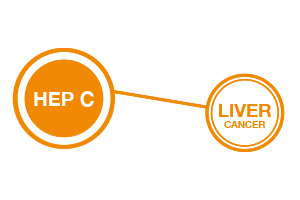You may be at increased risk for hepatitis C if you
Are exposed to blood in the workplace
Were born between 1945 and 1965
Have ever injected recreational drugs and shared needles
Received a blood transfusion or organ transplant before July 1992 (This is when blood and organs started being screened for hepatitis C.)
Got a tattoo or body piercing done with unsterile equipment
Were treated for a blood-clotting problem before 1987
Are on long-term hemodialysis
Are infected with HIV
Think About the Link® recommends :
Screening for those vulnerable to hepatitis C infection
Curative treatment for those living with hepatitis C to reduce the risk of liver cancer
Hepatitis C and Cancer
50 percent of all liver cancer cases in the United States are related to hepatitis C.
Hepatitis C & Liver Cancer in the United States
Each year, about 20,000 men and 8,000 women are diagnosed with liver cancer, and about 16,000 men and 7,000 women die from the disease.
Hispanic groups are more likely to die from hepatitis C-related causes than their white, non-Hispanic counterparts.
Approximately 3.5 million Americans are living with chronic hepatitis C infection and at least half of them are unaware of their infection.
Over 85 percent of hepatitis C cases can be cured with the right medical treatment.
81 percent of American adults with hepatitis C are baby boomers.
Hepatitis C killed more Americans than any other infectious disease in 2014.
The Virus
Hepatitis C is the leading cause of liver cancer in the United States. Hepatitis C is commonly transmitted by sharing needles or other recreational drug-injection equipment. People born between 1945 and 1965 are at higher risk for hepatitis C infection; however recent studies show that Hispanic populations are being infected at earlier ages. Hepatitis C becomes a chronic infection for 75 percent to 85 percent of infected people, but for some, it can also be a short-term illness.
The Cancer Link
Hepatitis C does not often show signs and symptoms. People with short-term hepatitis C show no symptoms, or exhibit mild symptoms including, but not limited to, fever, fatigue, dark urine and abdominal pain. Chronic cases of hepatitis C often show no symptoms and are more likely to develop into cirrhosis (liver decay) or liver cancer.
Most people do not know they have hepatitis C and do not receive treatment that can help prevent them from developing liver cancer. Hispanic individuals often progress to liver cancer faster than other racial/ethnic groups. Furthermore, the rate of new liver cancer cases among Hispanic groups are twice as high as those among white, non-Hispanic groups. The good news is that there is are several more treatments for hepatitis C, which can often cure you and reduce your risk of liver cancer.
Over 85 percent of hepatitis C cases can be cured
While no vaccine exists to prevent hepatitis C, you can reduce your chance of infection by avoiding activities that spread the virus, especially using injectable drugs. There are blood tests that you can take to check for hepatitis C. If you are at risk, talk to your health care provider about getting screened. If you have hepatitis C, there are several treatments available that can cure you and reduce your chance of developing cirrhosis (liver decay) or liver cancer.
Think About the Link® recommends

Screening for those vulnerable to hepatitis C infection.

Curative treatment for those living with hepatitis C to reduce the risk of liver cancer.
Did You Know?
Only 11 percent of baby boomers (born between 1945 and 1965) are aware of the higher rate of hepatitis C-induced cancers among their demographic.
One in eight Hispanic adults are aware Hispanic adults have higher rates of hepatitis C-associated liver cancer.
73 percent of adults are unaware hepatitis C treatment can reduce the risk of liver cancer.
91 percent of adults say their health care provider has never discussed prevention strategies for hepatitis C.
Health care providers report only 59 percent of patients diagnosed with hepatitis C ultimately receive treatment.